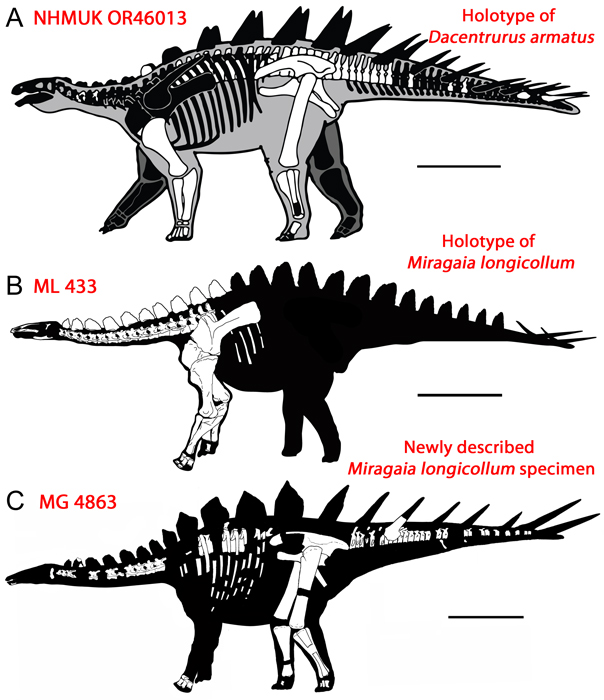Newly Described Specimen of Miragaia longicollum helps to Decipher the Dacentrurinae
A fossil of a stegosaur discovered in 1959 on the coast of western Portugal has helped to decipher the taxonomic relationships of an obscure sub-family of armoured dinosaurs known from the Late Jurassic. The specimen number MG 4863 has been identified as an example of Miragaia longicollum, a stegosaur named and described in 2009 from fossils found some 6 miles (10 kilometres) further inland.
Amazing Stegosaur Fossil Specimen
MG 4863 has been described as a “Rosetta Stone” specimen, just as the discovery of the Rosetta Stone was vital in helping scholars to interpret and understand ancient Egyptian hieroglyphics, these fossils, that had languished in storage for sixty years, can help palaeontologists to distinguish between different genera of closely related stegosaurs.
Laid Out in an Approximate Skeletal Reconstruction (MG 4863) – Newly Described Miragaia longicollum Specimen

Picture credit: Costa and Mateus published in PLOS One
The picture (above), shows the fossil material associated with MG 4863 prior to preparation (September 2015) and after preparation (May 2017). The fossils have been positioned in an approximate skeletal layout, the box in (B) contains unidentified fossil fragments.
Miragaia longicollum
Although far from complete and lacking any evidence of a skull, these fossils, that had been stored in an unprepared state at the Alfragide campus of LNEG (Laboratório Nacional de Energia e Geologia, Portugal), consist of bones that were not part of the original holotype specimen for M. longicollum (specimen number ML 433). Thus, palaeontologists have more parts of the skeleton of Miragaia longicollum to study and this newly described specimen has helped to decipher the differences between Miragaia and the closely related Dacentrurus.
The Dacentrurinae Deciphered
The first armoured dinosaur to be scientifically described was Dacentrurus armatus (although it was originally named Omosaurus armatus by the famous English palaeontologist Richard Owen). It was named from a jumbled up set of bones preserved in a block discovered in a clay quarry in Wiltshire (southern England).
The fossilised bones mostly represent the back-end (posterior) portions of an armoured dinosaur. For a considerable period, stegosaur fossils from strata approximately the same age from the Iberian peninsula were referred to as Dacentrurus. When ML 433 was excavated all that changed and this part of Europe had its very own stegosaur Miragaia longicollum. However, the holotype (ML 433), represented the front end (anterior) of the animal, so direct comparisons between Dacentrurus and Miragaia were not possible.
Now that palaeontologists have more fossils of Miragaia to study, thanks to the Alfragide campus specimen, clear differences between these two taxa can be identified, which reinforces their validity. In addition, ML 4863 is the the most complete dinosaur described from Portugal and the most complete stegosaur described from the whole of Europe.
Comparing the Holotypes of Dacentrurus armatus and Miragaia longicollum with the Newly Described Miragaia Material (ML 4863)
Picture credit: Costa, Mateus et al published in PLOS One with additional annotation by Everything Dinosaur
Stegosaur Scientific Paper Published
Both the Miragaia holotype (ML 433) and this newly described specimen (MG 4863), are associated with the Upper Jurassic Lourinhã Formation. Writing in the on-line academic journal PLOS One, the researchers (Francisco Costa and Octávio Mateus), provide a revised diagnosis for both M. longicollum and D. armatus.
A Land Bridge Between Iberia and North America – Late Jurassic Faunal Interchange
Significantly, the scientists conclude that Miragaia was closely related to a Late Jurassic stegosaur named Alcovasaurus longispinus, which is known from hip bones and other fragmentary fossils associated with a Morrison Formation outcrop in Natrona County (Wyoming, USA). Not only does MG 4863 help to describe and define two European stegosaurs but it lends weight to the idea that there was an ephemeral land bridge between North America and Iberia that allowed faunal exchange.
A Scale Drawing of Miragaia longicollum
Picture credit: Everything Dinosaur
Dacentrurus and Miragaia are represented in the CollectA model range.
For example, here is a link to the CollectA Deluxe figures: CollectA Deluxe Prehistoric Life.
We have two species of the carnivorous Late Jurassic dinosaur Torvosaurus identified, one from the western United States (T. tanneri) and one from Portugal (T. gurneyi) and now the idea of there being links between the Iberian landmass and North America is reinforced by the conclusion that Miragaia from Portugal and Alcovasaurus from Wyoming were closely related. Indeed, Alcovasaurus is so similar to Miragaia that the researchers propose that it should be assigned to the same genus and renamed Miragaia longispinus.
To read Everything Dinosaur’s article from 2009 about the discovery of Miragaia longicollum: A New Long-necked Stegosaur from Portugal.
The Everything Dinosaur website: Everything Dinosaur.








Leave A Comment